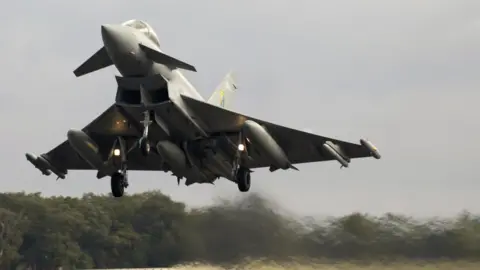Sonic boom heard over East of England as RAF intercepts civilian plane
 Ministry of Defence
Ministry of DefenceA sonic boom has been heard across the East of England after RAF Typhoon aircraft were launched to intercept a plane that had lost communications.
The Typhoons took off from RAF Coningsby and "safely escorted" the civilian aircraft to Stansted Airport in Essex, an RAF spokesman said.
The boom, at about 13:05 GMT, was reported by people across social media.
"The Typhoon aircraft were authorised to transit at supersonic speed for operational reasons," the RAF said.
'Numerous calls'
People in Cambridgeshire, Essex, Hertfordshire and parts of London heard the boom.
"We have received numerous calls from the public with reports of a sonic boom... between Huntingdon and Cambridge," Cambridgeshire police said, in a Facebook post.
"Nobody has been injured. Some callers reported the incident had shaken properties but no major damage is thought to have occurred."
 Cambridgeshire Police
Cambridgeshire PoliceCommunications with the aircraft were re-established after the Typhoons were launched and it was intercepted before being escorted to Stansted.
A spokesman for the airport said the "private jet" was believed to have been flying from Germany to Birmingham.
He confirmed the plane had been brought into land at about 13:40.

What causes a sonic boom?
When an aircraft approaches the speed of sound, the air in front of the nose of the plane builds up a pressure front because it has "nowhere to escape", said Dr Jim Wild of Lancaster University.
A sonic boom happens when that air "escapes", creating a ripple effect which can be heard on the ground as a loud thunderclap.
The speed of sound varies. It is about 770mph (1,200km/h) at sea level, but slower at higher altitudes. A plane flying at 30,000ft would reach the speed of sound at about 675mph (1,085km/h), according to NASA's educational website.
It can be heard over such a large area because it moves with the plane, rather like the wake of a boat spreading out behind the vessel.
RAF jets are only given permission to go supersonic over populated areas in emergencies, usually when they are required to intercept another aircraft.

Find BBC News: East of England on Facebook, Instagram and Twitter. If you have a story suggestion email [email protected]
